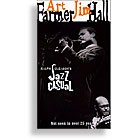
Jim Hall’s solo albums are consistently top-drawer – always eloquent and interesting, never samey or complacent. In fact, I’d be hard-pressed to name a jazz guitarist with a uniformly higher-caliber recorded output who isn’t…well, dead (like Django). But setting aside his forays as bandleader or solo performer, his collaborative efforts are perhaps even more impressive.
His 1950s work as a member of Chico Hamilton’s classic quintet and as one-third of the Jimmy Giuffre 3, not to mention his playing on Sonny Rollins’ ’62 classic, The Bridge, established Hall as a major force. Early-’60s sessions by Gary Burton and Paul Desmond, and his height-of-interplay duo settings with pianistic soulmate Bill Evans, showed it was his ears rather than his chops that set him apart – a quality he continued to display on duo efforts with bassists Ron Carter and Red Mitchell, as well as his recent tandem triumph with guitar disciple Pat Metheny.
In January ’64 he appeared on Ralph J. Gleason’s “Jazz Casual” television series, as essentially co-leader of flugelhornist Art Farmer’s quartet, with drummer Walter Perkins and bass legend-in-the-making Steve Swallow. As Farmer explains to Gleason, “When you have a guitarist of the caliber of Jim Hall, you really don’t need a piano. There are only a few piano players around who would be able to play with Jim, without being superficial.”
The show was only a half-hour long, so the band performs only four tunes, beginning with Irving Berlin’s bouncy “Change Partners.” Hall, then 33, takes one solo chorus on his Gibson ES-175 (with Van Eps string damper), but the undercurrent he supplies to Farmer’s warm melodies – whether providing a chord bed or taking the place of an additional horn, like his ascending quarter-note line after Art swaps fours with Perkins – is equally intriguing.
The group’s emphasis on standards, Farmer explains, mirrors its love of “tunes that are melodic.” Although half the set is ballads, it’s that melodicism that draws the listener in – for instance, Hall’s beautifully simple restatement of the melody on “Some Time Ago.”
Besides co-founding the Monterey Jazz Festival and Rolling Stone, the late Ralph J. Gleason was one of jazz’s best-known and most highly-respected critics. His “Jazz Casual” series, which began in ’59, gave viewers a rare opportunity to see jazz greats (such as John Coltrane, Dizzy Gillespie, Woody Herman, and Count Basie) play in a relaxed setting with few (or no) restrictions and no studio audience. Gleason’s interviews are especially intelligent and endearing.
Audio and video have been digitally remastered with great success for the Rhino releases, and are available in single-show VHS versions (for the price a CD, $14.98) or in more-bang-for-your-buck DVDs that combine three shows for only $29.99. Unfortunately, Rhino’s video wing doesn’t live up to its record division in all areas. For instance, the package’s liner notes (by Gleason’s son, Toby) could be more informative, and in some cases information is incomplete or incorrect – listing Farmer’s instrument as trumpet, even though Gleason’s interview begins with the jazz man explaining why he suspended using the trumpet in favor of flugelhorn (which isn’t as bad as reversing the drummer’s and bassist’s names on the Gerry Mulligan installment).
But even if there were a jazz TV show this cool today (and there isn’t), you could never regroup such amazing ensembles in their prime, let alone bring back deceased greats such as Farmer.
This article originally appeared in VG‘s May ’01 issue. All copyrights are by the author and Vintage Guitar magazine. Unauthorized replication or use is strictly prohibited.


